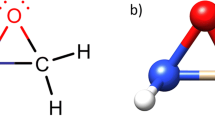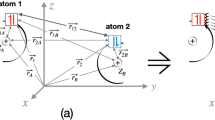Abstract
The resolution of identity (RI) approximation of second-order Møller–Plesset perturbation (MP2) theory, termed as RI-MP2, is applied to three-body fragment molecular orbital (FMO3) method. New implementation of FMO3 RI-MP2 is developed based on an efficient parallel RI-MP2 code developed recently in our group. Using this new implementation, the accuracy and computational time of FMO3 RI-MP2 calculations are assessed for water clusters, polyalanines, and proteins. The errors arising from RI-MP2 are sufficiently small in the FMO3 MP2 calculations that they give quantitative accuracy for practical chemical applications. Considerable time savings are attained in the FMO3 MP2 calculations with the application of RI-MP2.
Similar content being viewed by others
References
Fedorov DG, Kitaura K (eds) (2009) The fragment molecular orbital method: practical applications to large molecular systems. CRC Press, Boca Raton
Fedorov DG, Kitaura K (2006) In: Starikov EB, Lewis JP, Tanaka S (eds) Modern methods for theoretical physical chemistry of biopolymers. Elsevier, Amsterdam, pp 3–38
Nakano T, Mochizuki Y, Fukuzawa K, Amari S, Tanaka S (2006) In: Starikov EB, Lewis JP, Tanaka S (eds) Modern methods for theoretical physical chemistry of biopolymers. Elsevier, Amsterdam, pp 39–52
Fedorov DG, Kitaura K (2007) Extending the power of quantum chemistry to large systems with the fragment molecular orbital method. J Phys Chem A 111:6904–6914
Kitaura K, Ikeo E, Asada T, Nakano T, Uebayasi M (1999) Fragment molecular orbital method: an approximate computational method for large molecules. Chem Phys Lett 313:701–706
Nakano T, Kaminuma T, Sato T, Fukuzawa K, Akiyama Y, Uebayasi M, Kitaura K (2002) Fragment molecular orbital method: use of approximate electrostatic potential. Chem Phys Lett 351:475–480
Fedorov DG, Kitaura K (2004) The importance of three-body terms in the fragment molecular orbital method. J Chem Phys 120:6832–6840
Fedorov DG, Kitaura K (2006) The three-body fragment molecular orbital method for accurate calculations of large systems. Chem Phys Lett 433:182–187
Fedorov DG, Kitaura K (2005) Coupled-cluster theory based upon the fragment molecular-orbital method. J Chem Phys 123:134103
Fedorov DG, Ishimura K, Ishida T, Kitaura K, Pulay P, Nagase S (2007) Accuracy of the three-body fragment molecular orbital method applied to Møller–Plesset perturbation theory. J Comput Chem 28:1476–1484
Møller C, Plesset MS (1934) Note on an approximation treatment for many-electron systems. Phys Rev 46:618–622
Cremer D (1998) In: Schleyer PvR, Aliinger NL, Clark T, Gasteiger J, Kollman PA, Schaefer HF III, Shreiner PR (eds) Encyclopedia of computational chemistry. Wiley, Chichester, pp 1706–1735
Pople JA, Binkley JS, Seeger R (1976) Theoretical models incorporating electron correlation. Int J Quantum Chem Symp 10:1–19
Ishimura K, Pulay P, Nagase S (2006) A new parallel algorithm of MP2 energy calculations. J Comput Chem 27:407–413
Ishimura K, Pulay P, Nagase S (2007) New parallel algorithm for MP2 energy gradient calculations. J Comput Chem 28:2034–2042
Fedorov DG, Kitaura K (2004) Second order Møller–Plesset perturbation theory based upon the fragment molecular orbital method. J Chem Phys 121:2483–2490
Mochizuki Y, Nakano T, Koikegami S, Tanimori S, Abe Y, Nagashima U, Kitaura K (2004) A parallelized integral-direct second-order Møller–Plesset perturbation theory method with a fragment molecular orbital scheme. Theor Chem Acc 112:442–452
Mochizuki Y, Koikegami S, Nakano T, Amari S, Kitaura K (2004) Large scale MP2 calculations with fragment molecular orbital scheme. Chem Phys Lett 396:473–479
Mochizuki Y, Yamashita K, Murase T, Nakano T, Fukuzawa K, Takematsu K, Watanabe H, Tanaka S (2008) Large scale FMO-MP2 calculations on a massively parallel-vector computer. Chem Phys Lett 457:396–403
Fukuzawa K, Mochizuki Y, Tanaka S, Kitaura K, Nakano T (2006) Molecular interactions between estrogen receptor and its ligand studied by the ab initio fragment molecular orbital method. J Phys Chem B 110:16102–16110
Nakanishi I, Fedorov DG, Kitaura K (2007) Molecular recognition mechanism of FK506 binding protein: an all-electron fragment molecular orbital study. Proteins Struct Funct Bioinform 68:145–158
Ishikawa T, Kuwata K (2009) Fragment molecular orbital calculation using the RI-MP2 method. Chem Phys Lett 474:195–198
Okiyama Y, Nakano T, Yamashita K, Mochizuki Y, Taguchi N, Tanaka S (2010) Acceleration of fragment molecular orbital calculations with Cholesky decomposition approach. Chem Phys Lett 490:84–89
Feyereisen M, Fitzgerald G, Komornicki A (1993) Use of approximate integrals in ab initio theory. an application in MP2 energy calculations. Chem Phys Lett 208:359–363
Bernholdt DE, Harrison RJ (1996) Large-scale correlated electronic structure calculations: the RI-MP2 method on parallel computers. Chem Phys Lett 250:477–484
Weigend F, Häser M (1997) RI-MP2: first derivatives and global consistency. Theor Chem Acc 97:331–340
Weigend F, Köhn A, Hättig C (2002) Efficient use of the correlation consistent basis sets in resolution of the identity MP2 calculations. J Chem Phys 116:3175–3183
Katouda M, Nagase S (2009) Efficient parallel algorithm of second-order Møller–Plesset perturbation theory with resolution-of-identity approximation (RI-MP2). Int J Quant Chem 109:2121–2130
Rahalkar AP, Katouda M, Gadre SR, Nagase S (2010) Molecular tailoring approach in conjunction with MP2 and RI-MP2 codes: a comparison with fragment molecular orbital method. J Comput Chem 31:2405–2418
Katouda M, Nagase S (2010) Application of second-order Møller–Plesset perturbation theory with resolution-of-identity approximation to periodic systems. J Chem Phys 133:184103
Vahtras O, Almlöf J, Feyereisen MW (1993) Integral approximations for LCAO-SCF calculations. Chem Phys Lett 213:514–518
Kendall RA, Früchtl HA (1997) The impact of the resolution of the identity approximate integral method on modern ab initio algorithm development. Theor Chem Acc 97:158–163
Schmidt MW, Baldridge KK, Boatz JA, Elbert ST, Gordon MS, Jensen JH, Koseki S, Matsunaga N, Nguyen KA, Su S, Windus TL, Dupuis M, Montgomery JA (1993) General atomic and molecular electronic structure system. J Comput Chem 14:1347–1363
Gordon MS, Schmidt MW (2005) In: Dykstra CE, Frenking G, Kim KS, Scuseria GE (eds) Theory and applications of computational chemistry: the first forty years. Elsevier, Amsterdam, pp 1167–1189
Hehre WJ, Ditchfield R, Pople JA (1972) Self—consistent molecular orbital methods. XII. Further extensions of gaussian—type basis sets for use in molecular orbital studies of organic molecules. J Chem Phys 56:2257–2261
Hariharan PC, Pople JA (1973) The influence of polarization functions on molecular orbital hydrogenation energies. Theor Chim Acta 28:213–222
Krishnan R, Binkley JS, Seeger R, Pople JA (1980) Self—consistent molecular orbital methods. XX. A basis set for correlated wave functions. J Chem Phys 72:650–654
Acknowledgments
The author thanks Prof. Shigeru Nagase for reading the manuscript carefully and giving many suggestive comments. The author also thanks Prof. Kazuo Kitaura, Dr. Hiroaki Umeda, and Dr. Dmitri G. Fedorov for fruitful discussions. This work was supported by the Nanoscience Program in the Next Generation Super Computing Project of the MEXT. Some preliminary calculations were performed at the Research Center for Computational Science, Okazaki, Japan.
Author information
Authors and Affiliations
Corresponding author
Additional information
Dedicated to Professor Shigeru Nagase on the occasion of his 65th birthday and published as part of the Nagase Festschrift Issue.
Rights and permissions
About this article
Cite this article
Katouda, M. Application of resolution of identity approximation of second-order Møller–Plesset perturbation theory to three-body fragment molecular orbital method. Theor Chem Acc 130, 449–453 (2011). https://doi.org/10.1007/s00214-011-1021-x
Received:
Accepted:
Published:
Issue Date:
DOI: https://doi.org/10.1007/s00214-011-1021-x




